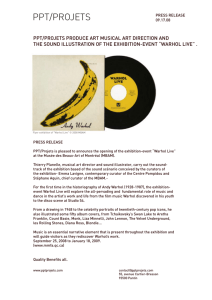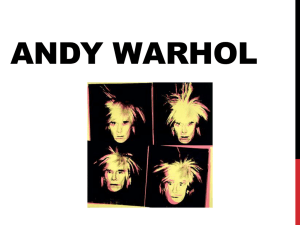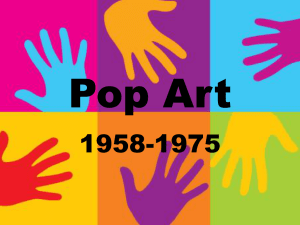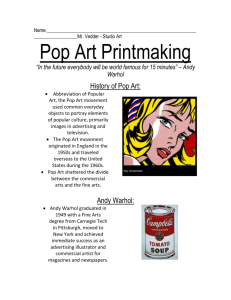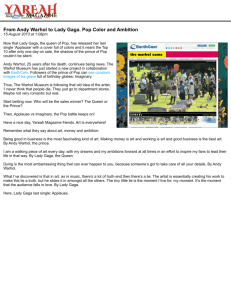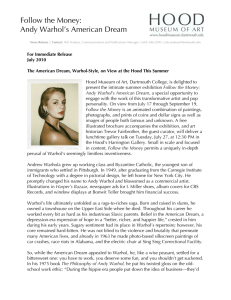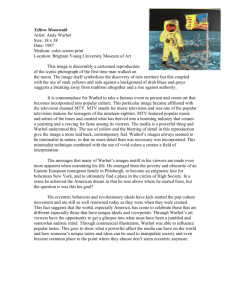TEAchERs
advertisement
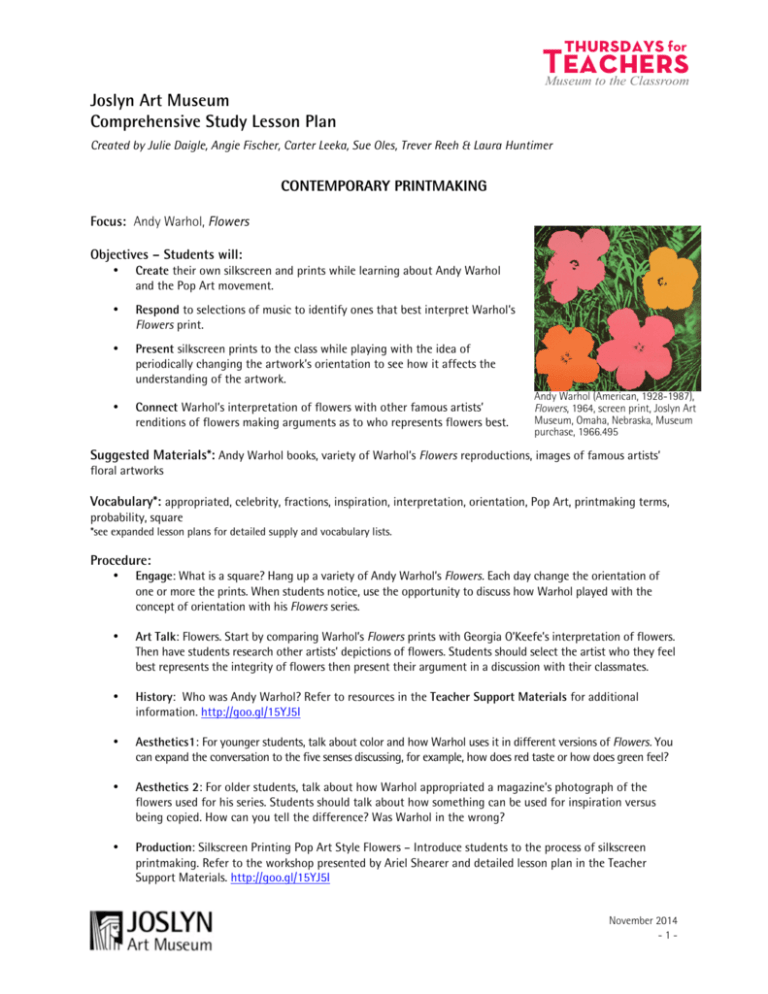
for T Museum to the Classroom Joslyn Art Museum Comprehensive Study Lesson Plan Created by Julie Daigle, Angie Fischer, Carter Leeka, Sue Oles, Trever Reeh & Laura Huntimer CONTEMPORARY PRINTMAKING Focus: Andy Warhol, Flowers Objectives – Students will: • Create their own silkscreen and prints while learning about Andy Warhol and the Pop Art movement. • Respond to selections of music to identify ones that best interpret Warhol’s Flowers print. • Present silkscreen prints to the class while playing with the idea of periodically changing the artwork’s orientation to see how it affects the understanding of the artwork. • Connect Warhol’s interpretation of flowers with other famous artists’ renditions of flowers making arguments as to who represents flowers best. Andy Warhol (American, 1928-1987), Flowers, 1964, screen print, Joslyn Art Museum, Omaha, Nebraska, Museum purchase, 1966.495 Suggested Materials*: Andy Warhol books, variety of Warhol’s Flowers reproductions, images of famous artists’ floral artworks Vocabulary*: appropriated, celebrity, fractions, inspiration, interpretation, orientation, Pop Art, printmaking terms, probability, square *see expanded lesson plans for detailed supply and vocabulary lists. Procedure: • Engage: What is a square? Hang up a variety of Andy Warhol’s Flowers. Each day change the orientation of one or more the prints. When students notice, use the opportunity to discuss how Warhol played with the concept of orientation with his Flowers series. = • Art Talk: Flowers. Start by comparing Warhol’s Flowers prints with Georgia O’Keefe’s interpretation of flowers. Then have students research other artists’ depictions of flowers. Students should select the artist who they feel best represents the integrity of flowers then present their argument in a discussion with their classmates. • History: Who was Andy Warhol? Refer to resources in the Teacher Support Materials for additional information. http://goo.gl/15YJ5I • Aesthetics1: For younger students, talk about color and how Warhol uses it in different versions of Flowers. You can expand the conversation to the five senses discussing, for example, how does red taste or how does green feel? • Aesthetics 2: For older students, talk about how Warhol appropriated a magazine’s photograph of the flowers used for his series. Students should talk about how something can be used for inspiration versus being copied. How can you tell the difference? Was Warhol in the wrong? • Production: Silkscreen Printing Pop Art Style Flowers – Introduce students to the process of silkscreen printmaking. Refer to the workshop presented by Ariel Shearer and detailed lesson plan in the Teacher Support Materials. http://goo.gl/15YJ5I November 2014 -1- for T Museum to the Classroom • Other: Flowers Sound Activity. Have students select the music they feel is the best interpretation of Flowers. Does the music selection change with the different color variations of Flowers? Refer to a list of suggested music in the Teacher Support Materials. http://goo.gl/15YJ5I This lesson is adapted from The Andy Warhol Museum’s “Camouflage Sound Activity.” http://goo.gl/tfNOVf • Close: Take the prints created in production and display for the class. Remember to encourage students to play with the orientation. In fact, have them cut up the image to create a new composition. Extensions: • Cultural Connections: Advertising. Talk about how Pop Art has its roots in graphic design and how it affected advertising. How has the field has evolved? Consider having students write a script for MadMen thinking about how the characters would react to Warhol’s point of view. • Fine Arts 1: Monoprint Pop Portraits. Introduce students to Warhol’s fascination with celebrities and prints of famous people while teaching them a monoprint technique. Refer to the workshop presented by Carey Hernandez and detailed lesson plan in the Teacher Support Materials. http://goo.gl/15YJ5I • Fine Arts 2: Screen Printing: Paper Cut Stencils. Teach students about color layering, shape, line, transparency, and positive/negative space with this screen printing process. Refer to the workshop presented by Joshua Norton and detailed lesson plan in the Teacher Support Materials. http://goo.gl/15YJ5I • Language Arts 1: For younger students, discuss Warhol’s start in comics. Then give them a copy of Flowers and ask them to draw speech balloons or thought balloons for each flower to tell a story or perhaps a moment of a story. Share them with the class. • Language Arts 2: For older students, share Warhol’s quote “Art is what you can get away with.” Have them bring a functional item from home. Students should write out an argument as to why the item’s design should be considered art. • Math 1: For younger students, use Flowers to discuss fractions by breaking up the image colors in 1/4 and 1/2. They could also divide up each individual flower’s petals. • Math 2: For older students, use the artwork to discuss the concept of probability. How many different color combinations are possible with the Flowers composition? • Science: The anatomy of a flower. Have students identify and research the flower Warhol featured in this significant print series. Discuss the difference between this version and a scientific illustration. Perhaps assign students to create a scientific illustration to display with their favorite version of Warhol’s Flowers. Academic Standards & additional resources: Available on online version at www.joslyn.org/education/teachers/thursdays-for-teachers [select Lesson Plans, then Modern & Contemporary] About the Artwork: In 1964 Metropolitan Museum of Art curator Henry Geldzahler allegedly suggested to Warhol that he paint something “fun and joyous.” Having spent the early 1960s feeding his predilection for the macabre by portraying fatal car crashes, assassinations, and race riots, Warhol took Geldzahler’s advice and shifted his attention to an entirely different theme: flowers. As he had done with the electric chair, Warhol turned to print media for inspiration for this new series, selecting an image from a June 1964 Modern Photography magazine article. After cropping and amplifying the contrast of the source image, Warhol applied a dizzying array of intense colors to the flowers. More psychedelic than naturalistic, these prints reflect the inauthentic experience of looking at an altered image, reminding viewers that a photograph, like any other art form, represents a specific point of view. November 2014 -2-

